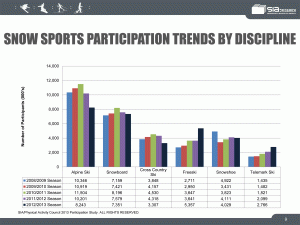
Telemark (aka BC) Skiing continues to grow while the larger Alpine and Snowboard numbers have declined.
The latest Participation Report from SIA indicates a few trends you might expect, and one that continues to confound the free heel faithful. As you would expect after two years in a row with below normal snow levels participation in skiing was down this last year, but only by 2% according to the SIA report.
Yet the ranks of telemark skiers continued to grow. Based on interviews with over 40,000 people, SIA claims the number of free heel skiers has nearly doubled in the past three years with 2.8 million people telemark skiing. As much as I’d like to believe that, it is results like that which cast serious suspicion on the validity of the rest of the report.
Now, if you consider telemark to be synonymous with backcountry as interchangable terms then some of SIA’s numbers can be believed. Kelly Davis, Director of Research at SIA admits, “The tele numbers are funny.”
Quoting a reference in the original report she wryly asks, “what’s a casual telemark skier?” The tele faithful know the answer to that one, it’s called an ex-telemark skier. Her implication? The size and scope of the survey miss the mark with specialty interests, but the demographics – age, income, and location do reflect reality. For instance, telemark skiers comprise 8.9% of the total snow slider population. Again, if you equate tele with backcountry, that sounds about right.
Another example is the average number of days per season. Telemarkers take the lead with 13 per year, snowboarders follow close behind with 11.3, reflecting stronger interest and dedication to sliding on snow.
Equipment SalesWhen you combine the information from SIA’s Backcountry Market Report for last season things begin to look realistic. The strongest indication that telemark numbers are off come from equipment sales reports. If there really were 2.7-million telemark skiers, or even the more inclusive term free-heel skiers, the equipment sales of only $3.4-million in telemark gear do not exist to justify that number. When you add $17.8-million in AT gear sales it looks better.
Where are they sliding?When those specialty interests are interpreted out of the data, like disqualifying the “casual” telemarkers, Kelly says the numbers are more like 800-thousand telemark skiers. Looking at SIA’s backcountry report that same number can be approximated by looking at the two Backcountry Participation graphs (Where do Sliders slide? & Where do Skiers slide?) and doing a bit of arithmetic to filter out snowboarding. The results don’t quite hit the 800k mark, but do fit with my experience on the size of the BC population, and the popularity of going out of bounds from the resort.
Still growing, or flat?
Looking closer at the Where You Have Participated in Skiing graph (Where Skiers slide), a few things stand out. The peak of interest over the past five years was three years ago, when western states had an above average snowpack. In the two years since then snowfall and days on snow have declined. This tends to suggest that interest in backcountry is waning, or has reached saturation. Except that in-spite of two years of below average snowfall the numbers of No Boundaries BC skiers increased 34%.
While the tendency exists to dismiss skiers and snowboarders who slide out of bounds as merely slackcountry riders the reality is the dangers are the same there as they are further from the boundary. Furthermore, if they are hiking at all then they are buying equipment that is equally valid no matter how far it strays from the lifts. Unlike resort skiing, equipment sales are the only way to reliably judge the health of the backcountry market and this is where the report gets rosy.
Alpine Touring DominatesAlpine Touring continues to lead equipment sales of BC equipment. According to SIA numbers there were around 90,000 pair of AT boots sold last season. The lions share, 77,000 worth, were boots with an alpine DIN sole for use with an alpine resort binding or a BC passport binding. 13,000 of those were dedicated BC boots with lugged soles and/or Dynafit inserts. By modern standards many of the new BC worthy boots are considered only acceptable for short jaunts out of bounds. Indeed, some may be buying them less for their BC functionality and more to simply make the walk across the parking lot more comfortable. It is a lot easier to earn your turns with the right equipment.
In the end, the high numbers in telemark don’t make sense because of the absence of other telemark specific information. It is clear that interest in the backcountry is not going away, but telemark is hardly the popular mode of travel anymore. Some of you are wondering what all the fuss is about with telemark, afterall, tele is dead, right?
I don’t care that you don’t care about telemark, or that there’s a group who have an on-snow identity with that term. I do care that statistics relating to telemark are so inaccurate. Then again, considering how small we are as a group pretty much guarantees how little respect we will get from a democratic majority. Obviously we certainly cannot match their brute strength in numbers, but then again, tele has never been about brute strength or numbers – it’s a movement.
In some ways I’m relieved tele has fallen off the statistical radar. Now I can just practice the craft and if someone is interested they’ll ask. If not, I won’t bore them (except in gear reviews on this site). It never legitimately made it past a million knee dippers in the USA, but we sure got some great gear out of being in the limelight for awhile, eh? And for those who don’t, or won’t tele, interest in AT continues to bridge the gap between just burning turns in-bounds and earning them in the backcountry.
© 2013

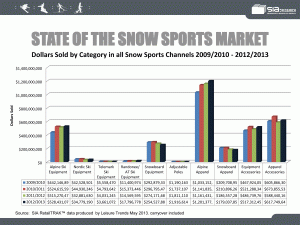
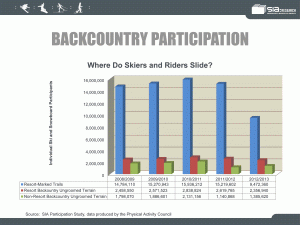
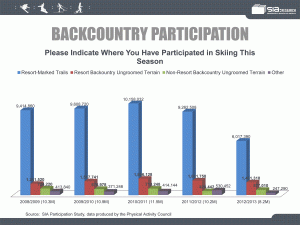
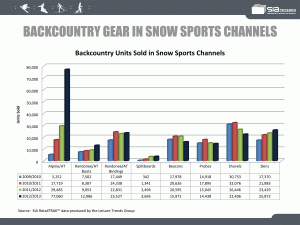
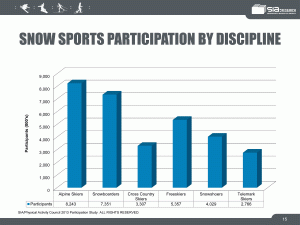
5 comments
1 ping
Skip to comment form
The terms have proliferated in pace with the gear options in the freeheel game. XC, XCD, Nordic, classic, skating, TTS, Telemark, AT etc. No wonder it’s hard to get good stats.
In terms of disciplines, those are some weird categories. Is “freeskier” the same as AT? I’m an alpine and backcountry skier who makes alpine and telemark turns using a freeheel binding. sometimes on “cross-country” gear. Where do I fit in?
@baaahb:disqus,
You’re off the chart…LOL!
It makes total sense. Telemarkers are cheap and never buy new gear. They just fix their broken bindings in their garage and brag about it in between bites of granola on the trail.
As long as there are small ski hills that don’t pack a big challenge, alpine skiers will free the heel just for the new challenge. I came to tele for this reason 20 years ago and now every time I put on the alpine gear and think about switching back it just feels too stiff and restrictive. Bless the hearts of those ex tele skiers that switch to AT and unload their gear for cheap.
[…] year so this is a good sign of health for telemark equipment sales, though it does not substantiate SIA’s claim of more than 2-million active telemark skiers in the […]